Claire worked and wrote for Sight Seeker’s Delight for 7 years – read more here.
Ecology in Paris is not an abstract idea, it’s our health, our quality of life, and the means of the future.
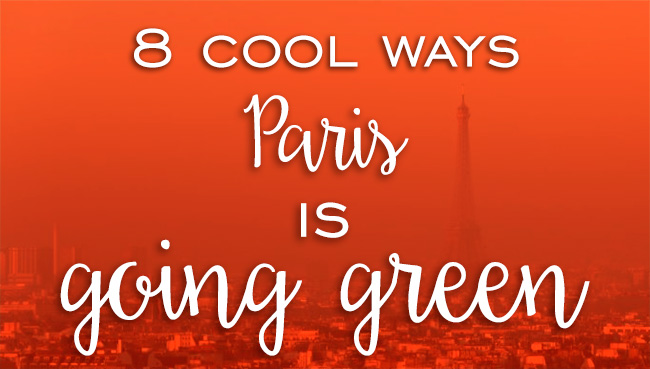
That’s a quote from Anne Hidalgo, mayor of Paris. She’s been a big factor in Paris’ recent push to be less polluting and more ecological. Of course as the city that hosted the COP21 Conference on climate change, and also gave its name to the Paris Agreement (climate accord signed by all but 3 nations worldwide), what would you expect?
That said, pollution in Paris is a BIG problem. One so big that the City of Lights is actually being sued for it.
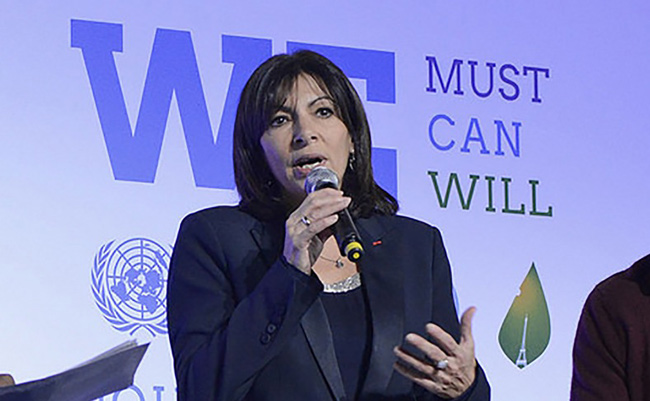
Mayor Anne Hidalgo. Image: affichesparisiennes.com
Here are a few nasty numbers to start with, but never fear! We’ll boost you up in a second and restore your faith in humanity by telling you the coolest and most interesting ways Paris is going Green.
- Cities are already responsible for 70% of carbon emissions.
- Parisians produce 1.1 million tons of waste per year – that’s about 1350 pounds per household.
- The majority of this waste (80%) is disposed of in incinerators despite the fact that half of it is recyclable material.
- Air pollution kills 48,000 people a year in France, causing illnesses such as lung cancer, stroke, and heart disease.
Hidalgo has said,
“Cities are where the future happens first. All of which means that mayors have an obligation to drive innovation and action. Mayors are on the front lines, especially when it comes to the greatest threat that our cities face–climate change.”
The previous mayor of Paris Bertrand Delanoë, (mayor from 2002 to 2014) believed this too. He didn’t act as diligently as Hidalgo in terms of bringing ecological questions to the forefront of city discussions, true. However he did introduce Velib’, the Paris’ massive bike-share program, and also began the process of lowering speed limits throughout the city.
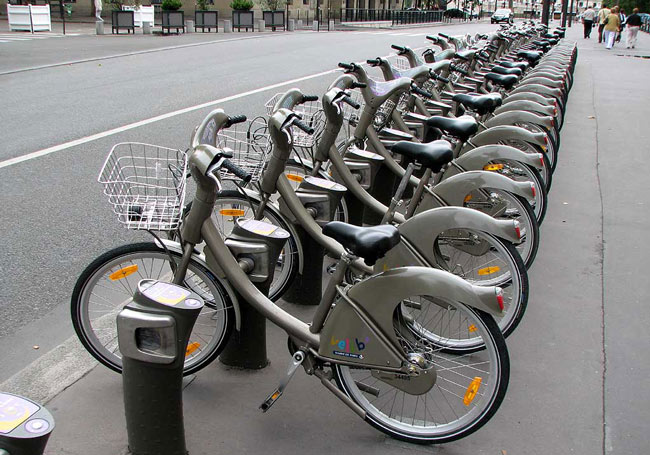
Post-cheese workout, anyone? Image: citiesnext.com
Paris wants to fight the list above (which is by no means exhaustive… I just didn’t want to depress you too much!) and reap all the benefits of promoting ecology and fighting against pollution. Here are some ways Paris is going green… a few might surprise you!
1. Urban gardens & Green Roofs
If you’ve walked around Paris recently, chances are you’ve seen some gardens right on the sidewalks. Often in wooden crates, these gardens can be anywhere – attached to the side of a building, railings, at the base of city-planted trees… These aren’t part of Paris’ regular gardening agenda though. These are created by individual citizens!
Here’s the best part: anyone can do it.
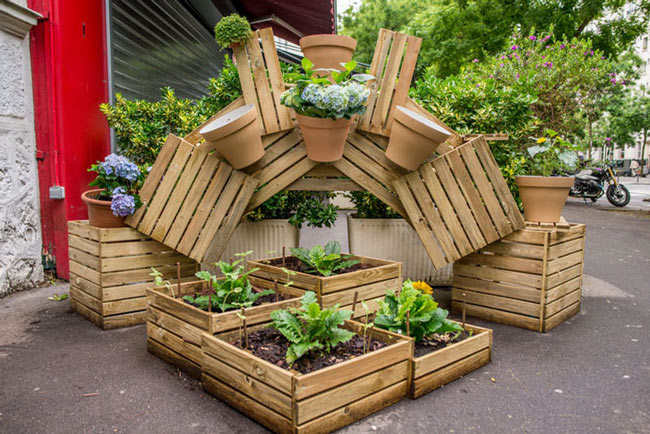
I want to hire whoever built this to put my IKEA furniture together for me. Image: boredpanda.com
Any resident can apply for a permit to “vegetalize” a small area. Once accepted, the urban garden can be installed within the city limits – in front of your apartment, your office, or even next to your bus stop.
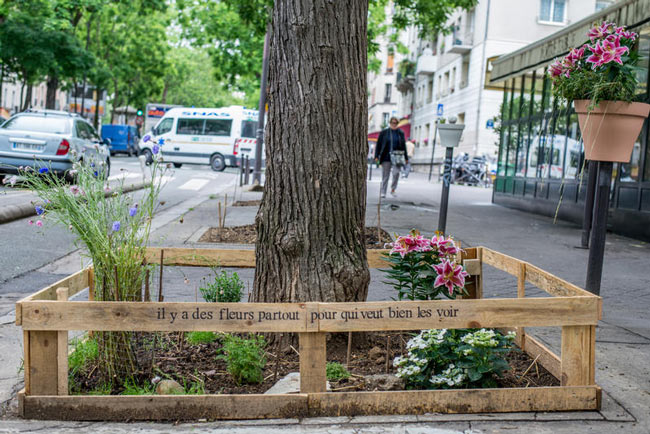
“Flowers are everywhere for those who want to see them”. Image: lareleveetlapeste.fr
Every green-thumbed-gardener is asked to use sustainable methods and avoid pesticides. It’s also part of the permit stipulations that the garde, is well maintained over the permit duration of 3 years. That means… don’t let it die!
THe goal is to have 250 acres (100 hectares) of living urban gardens (including green roofs) inside Paris by 2020.
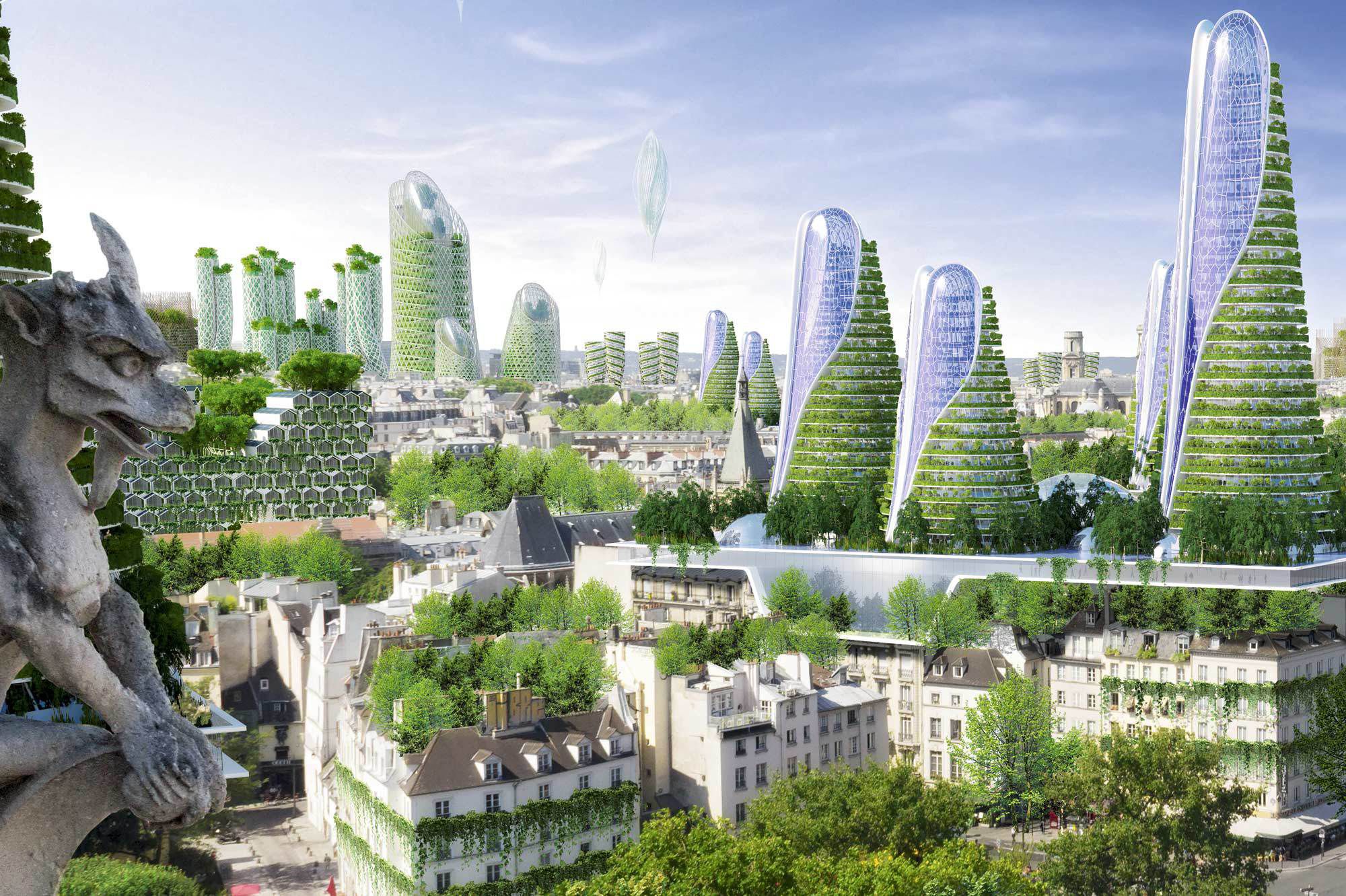
Not quiiiiiiite there yet though… Image: parismatch.fr
Speaking of green roofs… those are a thing in Paris, too! Hidlago proposed a green roof law in 2015 which unanimously passed France’s parliament. The premise? All newly built roofs feature either plants or solar-energy panels.
Reports show that green roofs can help offset a building’s carbon footprint by reducing energy costs, bringing down high urban temperatures and improving rainwater management.
.
2. River hovercraft boats
I’m not making this up.
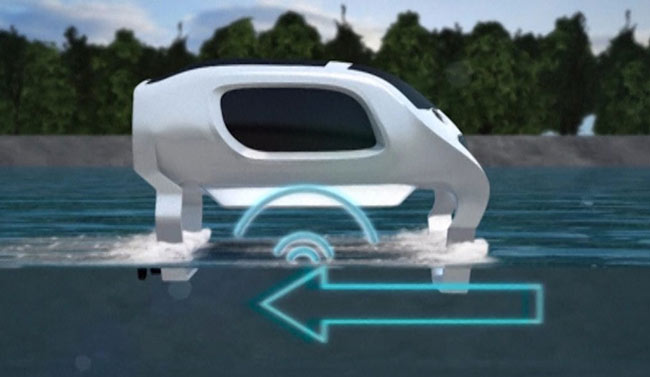
Science, or magic? You decide. Image: businessinsider.com
Sea Bubbles is a project that will put small hovercraft-type boats on the Seine for use as public transportation. The boats are powered by currents and solar energy, and the general technology is inspired by the fastest boat in the world: Hydroptere. After a certain speed, Hydroptere actually raises off the surface of the water thanks to wind beneath its wings (but no, not all boats have wings).
The boats are silent and use 100% renewable energy. French engineers have already made prototypes which should be tested this summer. We should know more after then… hopefully we will be some of the first to test them!
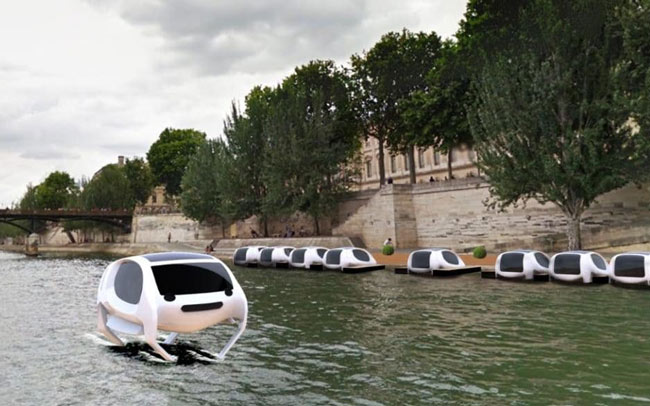
Next up, time machines! Image: telegraph.co.uk
Personally I am excited to see these things. If they can help de-clog some of those frequently-used city center buses, that will be terrific news for the environment and for Parisians in general.
.
3. Old polluting cars are banned
France has a system that seems a bit more lax than for example the USA’s emissions testing program. Air quality certificates are issued to cars based on how old they are and the gas they use. Though they aren’t mandatory throughout all of France, in Paris they are required.
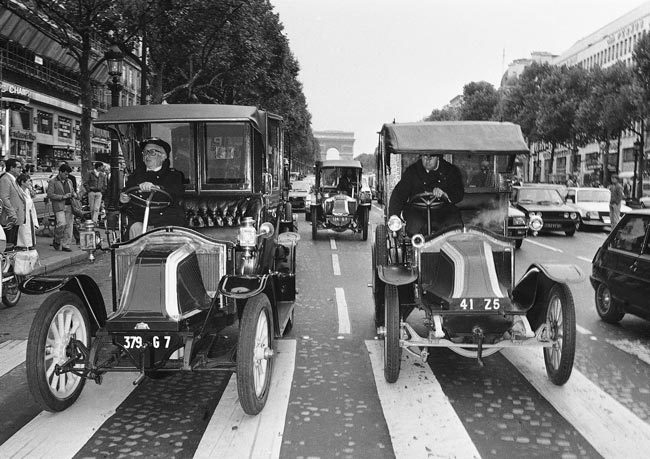
Sorry, guys. Image: vosizneias.com
Recently a law was passed banning diesel cars made before 1997 from the city center. The ban is in effect on weekdays from 8am – 8pm… so feel free to scoot around on that smoking-muffler-gas-guzzler in the middle of the night?
These certificates made it possible to pinpoint the oldest, most polluting cars and get them off the streets.
On days of exceptionally high pollution, half of all non-electric cars are banned from the city center. It’s a pretty intense step to take, but one that makes a real difference.
.
4. Electric car sharing
As you might know, Paris a city bike sharing program called Velib’ (combination of bike and freedom, velo and liberte, in French). Between all the Velib’ bikes, there are around 40 million rides per year.
In 2013 the city launched the car-sharing Autolib’ system. A couple years later the 100% electric Autolib’ Bluecar was introduced. Both have been a big success, just like their bike forebearer.
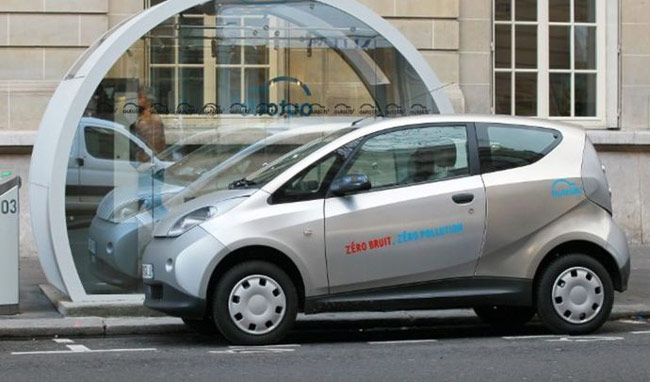
Vroom vroom, right into the future. Image: caradisiac.com
The Autolib’ system works about the same way as a city bike sharing system. Membership plan give preferential prices on hourly rates (12 vs 18 euros per hour for non members). You can rent and return your Autolib’ at any of the parking/charging stations throughout the city. There is even a charging services for private owners of electric cars – the recharge fee option costs only 15 euros per year, plus 1 euro per hour of charge.
The 4000 vehicles in the Paris region represent an estimated 165 million kilometers driven per year by combustion engine vehicles. Electric engine produces no micro particles or exhaust fumes, so that’s a really big deal!
.
5. Recycling (…duh)
France got a lot of press last year when a law passed by the Senate prohibited large shops (ie supermarkets) from throwing away good quality food approaching its best-before date.
Supermarket waste a real problem in France and around the world… In Paris, some 35000 tons of perfectly good, still packaged food is thrown away each year.
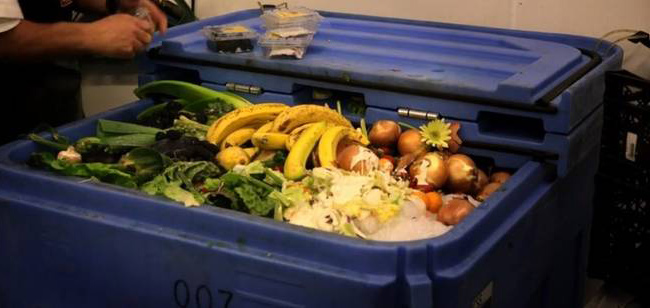
But think of the banana bread you could make! Image: treehugger.com
Under the same law, supermarkets are also barred from deliberately spoiling food in order to stop it being eaten out of the bins. Yes, believe it or not, some shops would actually pour bleach on their food waste, allegedly because of the risk of someone digging through and getting food poisoning from what they ate.
Instead, big shops must sign contracts with charity organizations to donate the food to.
As great as that law is, the level of household recycling in Paris still needs a lot of work. There is actually a good system in place even if many people don’t take advantage of it. Most apartment buildings have a “waste room” with one bin for normal trash, one for glass, and one for recyclables (paper, plastic, cardboard).
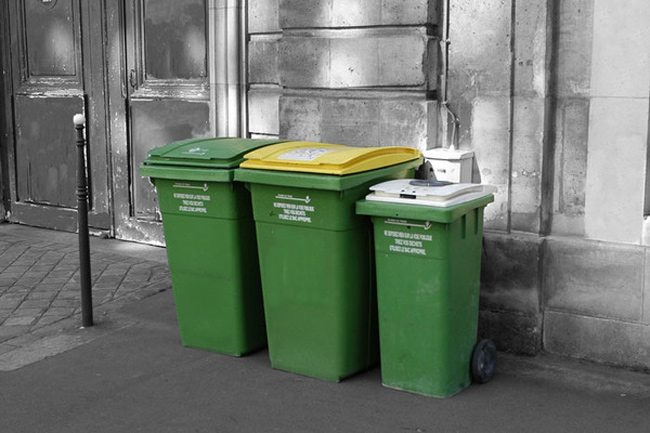
Now you know what to look for at your AirBnb. Image: paris.fr
For apartment buildings that don’t have space for the three separate bins (or a possible fourth, see below!), Paris is moving forward with plans to build hundreds of public recycling stations. Public glass recycling already exists, but now we’ll have paper/plastic recycling (the yellow bag) as well.
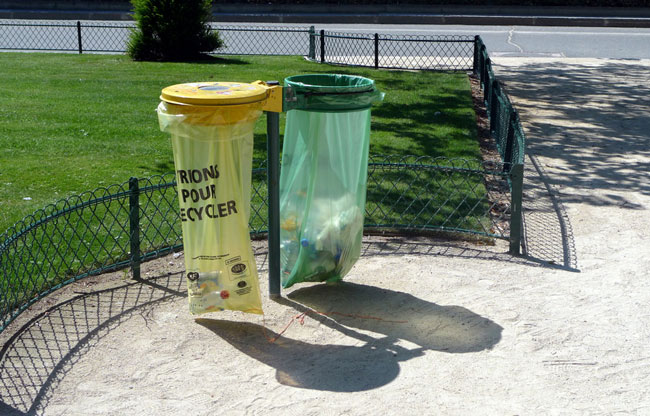
They’re not both for trash, people. Image: doudoufine-mondoblog.org
A new bio-waste initiative has also started in parts of Paris. Brown recycling bins have been given to apartments in a few neighborhoods for any food waste, like egg shells, tea bags, fruit peels… Your average compost filling!
The goal is for these brown bins to be available throughout the entire capital by 2020.
The food waste will be made into fertilizer, or even taken to methanisation plants to convert it into heat and electricity or bio fuel for buses.
.
6. Intersections redesigned for pedestrians
Part of the plan for a less polluting (and polluted) Paris is lowering the number of cars on the road. Oh and by the way, 80% of all cars in Paris are only being used to transport one single person. Which makes it a lot worse. Come on, haven’t you heard of carpooling?
How do you reduce cars on the road, short of slapping fines all over the place? One way is to redesign streets to favor pedestrians and bikers, instead of cars.
Or at least make things more equal! Especially seeing as how 50% of all Parisians don’t even own a car (much less use it regularly).
In large public spaces created by busy intersecting roads, traditionally huge traffic circles take up most of the space. That not only makes it a huge pain for a pedestrian to get through, but also encourages car traffic just by virtue of its design. Paris is now starting to recreate these spaces with greater thought towards pedestrians.
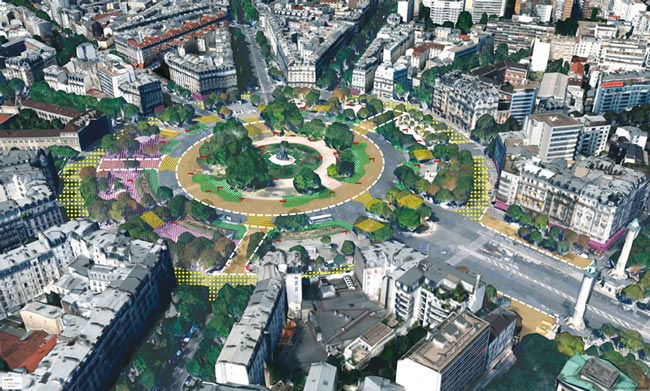
Future project for Place de la Nation, currently the “most boring place in the whole city” where there is “literally nothing to do”, according to Every Parisian Ever. Image: paris.fr
A handful of updated intersections are in the design phase and they allot 50% of the space to pedestrians. Obviously, this requires removing traffic lanes. That in turn makes it more difficult for drivers to get around. The hope is that this increased difficulty will discourage Parisians from choosing their car, and instead use one of the many other modes of transportation. (By the way, only 22% of drivers need their car to get around; the others drive because they choose their own comfort over the collective health of other Parisians).
Take one example that’s already been completed: Place de la Republique. It used to be a busy road and traffic circle, constantly filled with noisy polluting cars. Then in 2013 the Place was redesigned to incorporate a large open plaza for pedestrians.
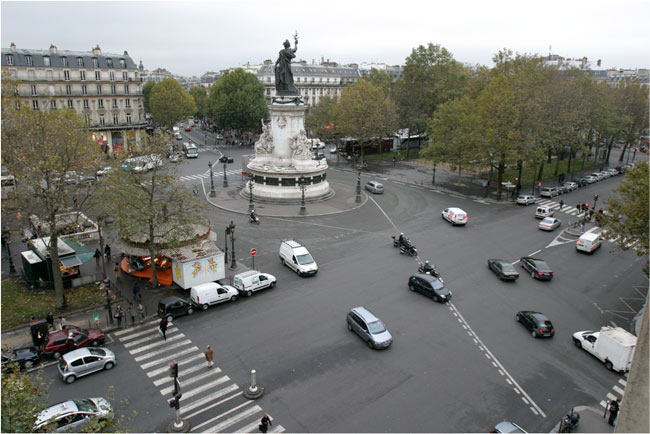
Place de la Republic before: a car haven. Image: paris.fr
Traffic lanes were removed and although surrounding area traffic increased for a while, afterwards it normalized. Meaning: Place de la Republic was more of a pain for cars (and nicer for the city’s many walkers and bikers), and thus actually decreased the number of polluting cars on the road.
The popularity of the Place de la Republique transformation prompted Paris officials to replicate it elsewhere in Paris. Plans have been proposed for Place de la Bastille, Place de la Madeline, Place de la Nation, and a few others.
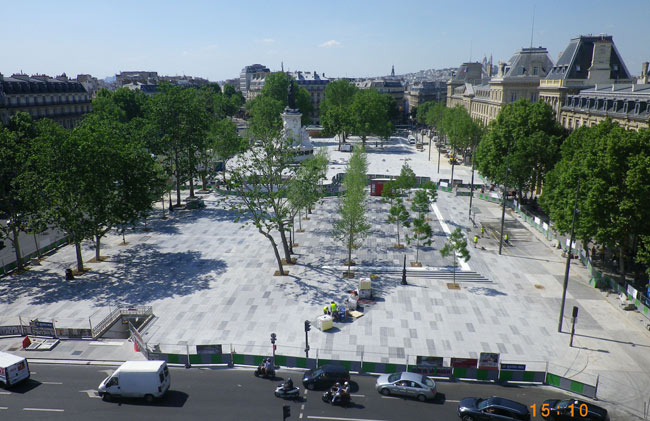
Place de la Republic after: a place people actually want to spend time in. Image: mineralservice.fr
Even Rue de Rivoli – one of the main thoroughfares in Paris – will be part of this green evolution. If you’ve been on Rue de Rivoli in the daytime (for example, shopping for macarons, madelines, or other sweet treats), you know the sound of traffic can make it almost impossible to have a conversation. Now there are plans to remove a lane of traffic and include a two-way bike path for the entirety of the big avenue.
.
7. Roads closed to cars in city center
There are quite a few projects in place already to re-pedestrianize the center of Paris. You’ve probably seen some unbelievably car-free photos of the Champs-Elysees on social media. That’s not Photoshop my friend, that’s a real thing. Cars are banned from the Avenue des Champs-Elysees once a month.
Yes, you heard correctly: The normally congested Avenue is turned into a pedestrian haven the first Sunday of every month!
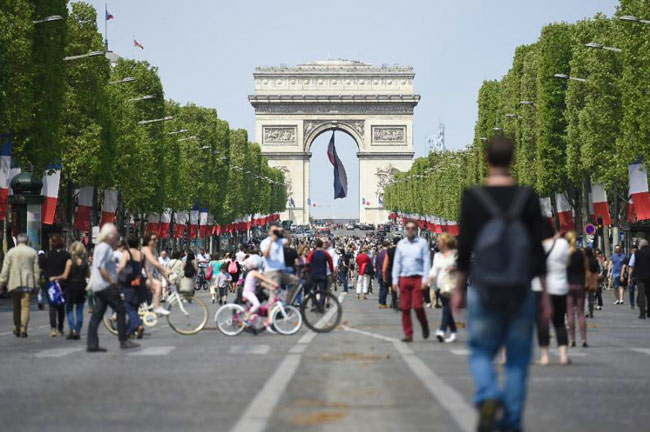
Image: amazonaws.com
That’s not the only change the famous Avenue will see in the near future. A bike path is in the works, which will run the length of the Champs-Elysees.
The new path will be a big win for the plan to double bike lanes in Paris by 2020. Over the next few years, Paris is trying to go from 430 miles of bike lanes, to 870. That’s great new for anyone who uses that Velib’ bike sharing system…
Then you have Les Berges de Seine, a river walk that opened up a few years ago on the banks of the Seine river, on what used to be a busy, noisy highway. A small portion of that highway was closed to cars and turned into a park for pedestrians.
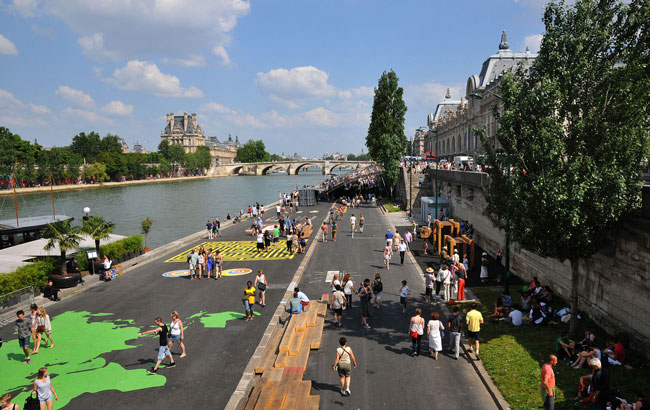
These boots were made for Walking, after all… Image:
This was such a success that Hidalgo pushed to transform the rest of the riverbank highway in the same way. She got her permission and the city got to work. Just a few months ago, it finally opened! Now on both sides of the Seine river, you can stroll right along the water and enjoy a beautiful, pollution-free afternoon. There are playgrounds, grass areas, gardens, cafes, rock climbing, sport classes, concerts, and more.
There are other notable planned street closures, notably Place du Carrousel, which is right in front of the Louvre. Hidalgo says the ultimate green goal is to remove cars altogether from the center of Paris. That seems unlikely, but working towards a better balance of sustainable transportation is never a bad thing!
.
8. “Grand Paris” transportation
When you make it hard for drivers to get around in their own cars, it’s pretty simple to see that you must put an alternative system in place for them. Paris has BIG plans for this… the “Grand Paris” project.
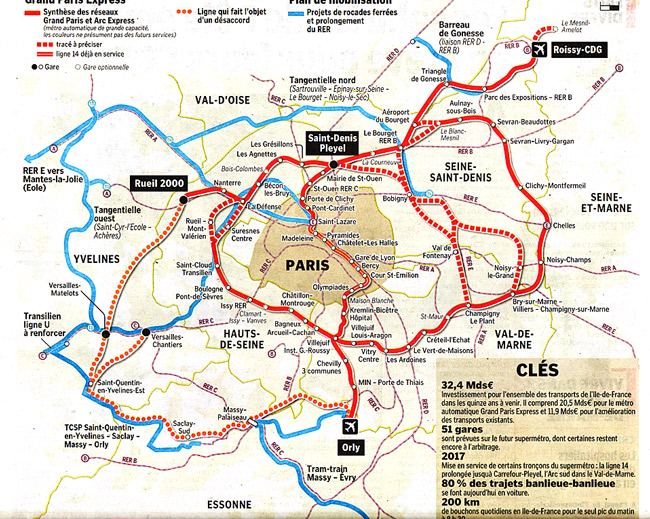
Grand Paris transport map, spiderweb… they’re basically the same. Image: Le Parisien
The Paris metro and train system is branching out, and getting green. The entire metro system is being modernized over the next 13 years. Metro lines will be extended to travel well into the suburbs, and 4 brand new lines will be created. This makes it much easier for suburbanites (many who work in Paris) to get around without cars.
The Grand Paris project will also make it easier to travel from suburb to suburb using public transport. Currently it’s a huge hassle to go from one suburb to another without a car. Often, your only option is to go all the way into central Paris, then switch lines and head all the way out of Paris again.
The combination of new tram lines and extensions of existing ones, will basically surround Paris in a circle. Similarly to the above suburb-suburb predicament, this will make it easy to get around the outskirts of Paris without having to travel to the city center and then back out again. Trams will also reinforce the bus network which is quite polluting and over-crowded.
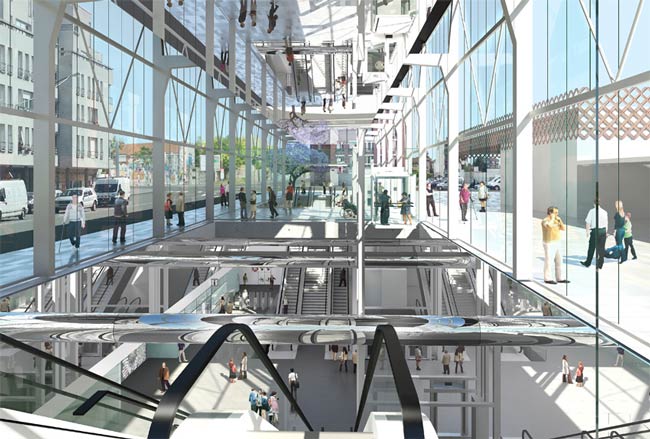
Image: connaissancedesenergies.org
Most of the new metro lines won’t start construction for another few years, so there aren’t too many details out there. However, extensions of existing lines (such as the ultra-fast and modern line 14) have already begun. In the end, public transport will do much more to connect Paris to its suburbs, and the suburbs to each other.
What do you think of these Green actions? Would you want your own city or town to employ any of them?
.

Hello, I am looking to site your article in a research paper but I need an additional source on one of your stats. Where did you find the information that Parisians produce 5 million tons of waste per year? I cannot find it anywhere else. Thanks!
Hello Cassidy, thank you for pointing out the error in this blog! Parisians actually produce 1.1 million tons of waste per year. You can read more about it here! We hope this helps!